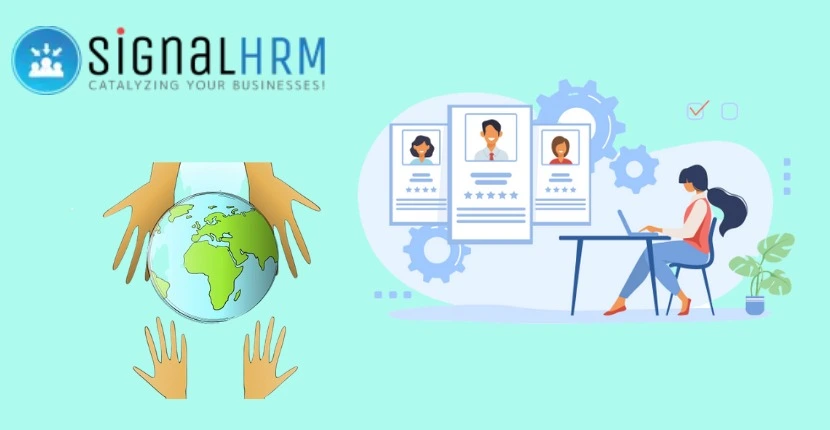
In our present world, climate change stands as one of the most urgent concerns. The Earth is undergoing notable shifts in temperature, with the rate of increase (per decade) having doubled since the 1980s. The causes behind global warming and climate change are numerous, with deforestation serving as a significant factor contributing to the loss of forest cover worldwide. To promote awareness about the detrimental impacts of deforestation on our lives and the well-being of future generations, the United Nations has designated March 21st as the International Day of Forests.
Now, the crucial question arises: How can we, as individuals, contribute to a more environmentally friendly planet? Fortunately, the worldwide shift towards digitalization is a positive development in support of our planet. You may wonder how. Well, digitalization has transitioned us from traditional paper-based methods to the digital realm. Tasks that once required significant amounts of paperwork are now being performed digitally through software applications.
The rise of digitalization has necessitated the development of tools and platforms to assist businesses in achieving complete paperless management of their operations. When it comes to managing Human Resources functions or HR functions, modern HR software has emerged as a solution that enables the HR department in enterprises to go paperless. This transition represents a significant stride towards environmental sustainability and a greener planet
The management of HR functions and the employee lifecycle traditionally entailed numerous paper-based processes, including employee onboarding, separation, performance evaluation, and employee information management, among others. However, with the introduction of HRMS software, the HR department now has the ability to eliminate the need for paper. This shift has not only contributed to environmental conservation but has also led to cost savings for enterprises.
Let's explore some of the HR functions that were once heavily reliant on paper and how they have been automated through modern HR software, transforming the way they are managed.
1. Leave Management
In the past, leave application requests were predominantly paper-based, requiring the maintenance of physical files for future reference. However, with the advent of HR software, leave requests can now be easily submitted and approved directly on the platform itself. What's even better is that the leave history of each employee is digitally stored in the database, allowing for swift generation of reports when needed. This digital transformation has significantly streamlined the leave management process.
2. Performance Evaluation and Management
Previously, performance management posed challenges due to the multitude of parameters to track and the sheer number of employees, often resulting in incomplete recognition of employee efforts. However, with the integration of HR software, the performance management system has undergone a complete transformation. The software has streamlined the process, enabling easy access to data for comprehensive analysis with just a click of a button. This empowers organizations to make informed decisions and ensure that employee contributions are duly acknowledged.
3. Employee Productivity Enhancement
The introduction of the Timesheets module in modern HR software has revolutionized how the HR department monitors and tracks employee productivity, as well as the time allocated to various tasks and projects. This module enables precise tracking of individual and team-level productivity, transforming the way employee performance is measured and managed.
4. Employee Attendance Tracking and Management
Do you recall the days when employees used to mark their attendance on a register placed at the office entrance? Thanks to HR software, administrators no longer need to maintain countless registers as records of employee attendance for extended periods. The automated attendance tracking platform is now synchronized with biometric attendance recorders, creating a seamless and tamper-proof process for recording attendance. This advancement ensures greater accuracy and efficiency in managing employee attendance compared to traditional methods.
5. Employee Onboarding and Offboarding
The employee onboarding and separation processes traditionally involved extensive paperwork, with numerous formalities, forms to be completed, and documentation to be recorded, including address proofs, qualifications documents, experience letters, and more. The sheer amount of paper consumed for each employee was substantial. However, with the advent of modern HR software, the reliance on paper has significantly diminished. All the necessary data is now stored digitally within the HR software platform, enabling easy retrieval and minimizing the need for physical paperwork. This digital transformation has streamlined and simplified the employee onboarding and separation procedures.
6. Travel and Expense Management
In the past, travel and expense management involved extensive paperwork, including managing tickets, travel bills, food expenses, transportation costs, and more. The process required handling significant amounts of paper documentation. However, with the implementation of HR software, everything is now digitally managed on the software platform. This digital transformation has streamlined the entire travel and expense management process. Additionally, reimbursements are now facilitated through a fully digitalized process, further enhancing efficiency and eliminating the need for excessive paperwork.
Apart from the aforementioned HR functions, numerous other HR tasks have been successfully digitized and automated through advanced HR software solutions available today. Therefore, it is evident that transitioning to an automated HR management approach is a significant stride for enterprises to minimize their carbon footprint and contribute to creating a more sustainable and habitable planet for future generations.